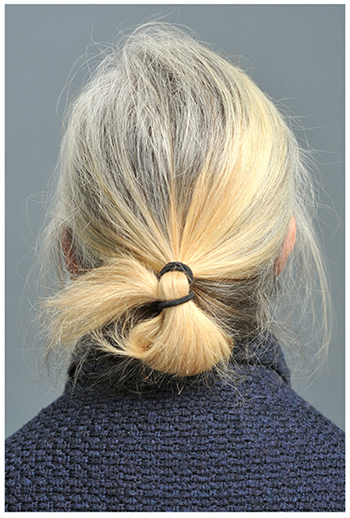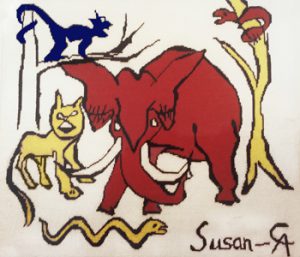About Susan Barnett
When George Harrison descended the steps of PanAm for the Beatles’ first visit to the United States he was carrying a Pentax Spotmatic camera. Susan, a big fan, decided then and there that her first camera was to be the same Spotmatic.
Her Father, an avid photographer, taught her photographic fundamentals by giving her assignments at an early age. He would give her one roll of Tri-X film and problems such as taking one light bulb as a light source to create a still life. She would go into the basement darkroom, develop her film and make her edit. On Sunday nights instead of watching Lassie, her Father would critique her work making suggestions and analyzing every photograph. She went to a very small girls school (Lacordaire Academy) so she became the high school photo editor for both the yearbook and newspaper. In 1973 her Father ceremoniously gave her his Leicaflex SL2 that she uses to this day.

She received her Bachelor of Arts in Art History and Studio Art from Marymount College in Tarrytown, New York where she did an internship at The Cloisters, the Medieval Branch of the Metropolitan Museum of Art. With that experience she was offered a job at the Perls Galleries on Madison Avenue, New York. That led to a long career working with one of a kind works of Picasso, Braque, Leger, Matisse, Maillol, Miro, Chagall and other artists of the School of Paris. She worked uptown during the week attending auctions at Sothebys and Christies and during lunch visited the Met, the Guggenheim and the Whitney. Next door to Perls was Light Gallery which was one of the earliest galleries to show contemporary photography. Here she saw the work of Harry Callahan, Robert Mapplethorpe and Garry Winogrand that was in many cases being shown for the first time. But on Saturday nights she took the subway downtown to the Spring Street station to attend the legendary openings at 420 West Broadway of the Leo Castelli and Sonnebend Galleries and to Mary Boone across the street. Andy Warhol was a regular downtown and Susan traded a needlepoint with him in exchange for a drawing.
Perls also represented Alexander Calder and was largely responsible for coordinating Calder’s major commissions throughout the world. Calder himself said that “Susan” was a favorite dance partner. At many of the opening parties he would jokingly call her a “living mobile” as he twirled her around the gallery floor. She was always seen with the signature silver “S” broach that Calder had given to her.
Her practice was to design and make needlepoints while sitting at the Perls’ front desk. One day Calder asked her to bring in a piece of canvas and he sat down and drew for her “The Family of Beasties”, the only known Calder needlepoint. He signed it as a collaboration with both names: Susan – CA … his well known signature. At his passing, the needlepoint was exhibited at the Memorial Exhibition held at the American Academy of Arts and Letters in 1977.

The Perls Galleries closed in 1997 by which time Susan had gone on to open her own gallery where she bought and sold on the secondary market to help promote and exhibit her artist friends. During this period, she also attended the School of Visual Arts studying graphic design and photography. In 2004 in a freak accident Susan lost sight in her right eye and since then her work has changed. She joins a long list of photographers and artists who are “monoscopic.” Many have reported the change in aspects of their work with issues such as a different spatial awareness and the change in the depth of field. Throughout, she continued to draw, photograph and make sculpture, exhibiting her photographs with installations of her sculptural “beaded identities.”
She then rented a studio downtown on Reade Street and the walk from her home on East 28th Street to Tribeca became the source of many of her early t-shirt photographs.
Her interest in the t-shirt began in her college years, when as a “student activist” she would work behind the scenes making the posters and silk-screening t-shirts used in anti-Vietnam war rallies. Sister Elizabeth McAlister (one of the Harrisburg Seven) taught art history at Marymount and was Susan’s student advisor. The student body was split between those protesting at West Point (right up the road) and those wanting to marry the cadets. There, in the Seventies, Susan silkscreened the popular anti-war slogan “Hell No! We Won’t Go!” That is the kind of message that was described as a “T-Shirt Time Capsule” years later in a New York Times article about Susan’s work Watching Your Back and What’s on It. The article described t-shirts as providing “a barometer of our times… an iconography of the streets.”
The typology of over 2000 images Not In Your Face was begun in 2009 and is on-going. As the typology has grown over the years, she has seen the messages change with the times. In 2009 Obama had just been elected and you could see many shirts with the slogan “Change Has Come.” Today we see the timely “Vote Incumbents Out” and there are many more sightings of potent swear words.
The t-shirt is here to stay and until they start making only white t-shirts (like Marlon Brando’s in 1953) Susan plans to continue the body of work along with her other projects. Her first book based on the series “Not In Your Face” is called T: A Typology of T-Shirts and was recently published by Dewi Lewis Publishing, UK.
Susan lives with her husband of 28 years, Jerry Barnett, and can be found sailing on Tiana Bay in Hampton Bays, Long Island on weekends. She continues as an art dealer and consultant for private clients. She focuses on The School of Paris and Twentieth Century Painting and Sculpture, with a special interest in the work of Alexander Calder.